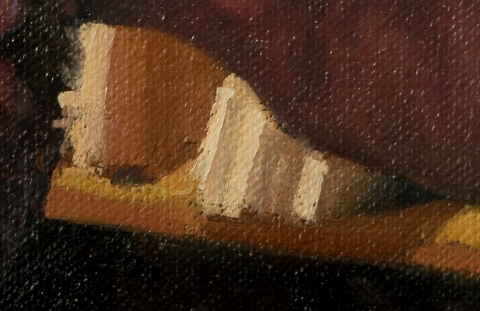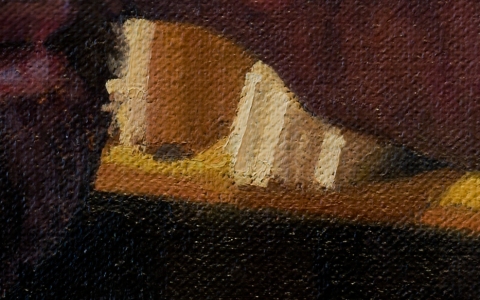Due respect, but this:
"If the lights face each other and are of equal power then there will be no shadow." ? No, and that's Lighting 101. I'd say if you think this is true, try lighting a pingpong ball with 4 lights and show me where the shadows go away...
You're missing my point on the brush stroke. Sure, the artist gives it the texture they want, that's exactly the point. My job is to reproduce that texture in a print - no more or less. Here are two examples - shot with standard "even" side lighting, and shot with the artist's studio lighting:


To see the full sized images go to the blog post, here:
https://teddillard.wordpress.com/category/fine-art-reproduction/Notice, in particular, that vertical brush line in the tan/beige tone in the center. The top image, lit traditionally and "technically correct", doesn't read the line of the stroke. The second shot defines it as the artist saw it when he painted it. It's subtle, I'll grant that, but it's important. If you look in other areas you'll see strokes and paint you can't even detect in the first example.
Anyway, I've done the science on the color on my blog (and in several years of research and testing - I'm an X-Rite "Coloratti", or at least was at one time... worked pretty closely with members of that team.
http://blog.xritephoto.com/2012/06/ted-dillard-light-sources-color-management/#sthash.Vd20So0F.dpbs). Again, respectfully, you're missing the point about that, as well as in the quality of the shadow and lighting. As simply put as I know how to say it, if you light a subject with green light, and only green light, how can you expect it to reflect red? The subject will only reflect the wavelengths you give it, though you can try to fabricate a response with a profile, as you are forced to do with "full spectrum" fluorescent. I use as full a spectrum as I can - daylight with tungsten added - because without a full spectrum, I don't get a full palette of
actual colors to print.
As far as shadows go, interestingly, in a North Light Studio the shadows under each stroke typically move to very cool, if not blue. You can see that pretty clearly with a white paint stroke, naturally. ...but, point being, I can make the shadows do whatever I feel they need to be doing, in color as well as values.
I'd suggest you do an few tests, since no amount of discussion really convinces anyone. Well, it never convinced
me, anyway...

Shoot a painting with a good, heavy texture paint application. To take the x-y easel out of the equation, let's use a small painting.
1) Light it with standard, two light copy lights, with or without polarizers, whatever your preference.
2) Shoot another version with 4 lights, again, standard copy arrangement.
3) Shoot it with a daylight, North light studio with not more than two down-spots, preferably halogen. Make sure you process using your Passport system, it handles that mix great.
4) For the sake of some
real interesting discussion, shoot the piece with LED lighting, pick your poison as to the lighting technique - then look at that file's histogram compared to the histogram from #3 - look at all 3 channels. (
https://www.youtube.com/watch?v=QcpGsLhp6K0)
Shoot, process, and look at the files at "Print Size". Now look at the images zoomed in until you can see the detail of the brush strokes and shadows on them.
Make some prints. Note the differences between the color range with the North Light studio lighting, particularly with a painting with difficult, gamut-stretching color. If possible, show the prints to the artist and see what they like best. Come to your own conclusions...
(Yep, it's a lot of work, I know because I've done all of that, for several years, as well as running some actual science.

I've also proven out the "theory" with about 5 years of using the method and hearing artists' reactions... that's when I hear about the photographers they used to use, who "never really got it right". My pricing, by the way, is no more expensive than most lab's standard "high resolution" capture.)
My conclusions are that a North Light studio emulates the lighting that the painting most often is viewed under, both in quality and in color. Virtually every gallery I've ever been to has a combination of halogen spots and ambient daylight fill. Most artists that I work with work under similar conditions, with ambient daylight, and work lights or halogen spots - even when they say they have a North Light studio, they still add the task lighting. If I shoot that way, my lighting looks familiar to the artist, and the color of the capture is easier to print.
---back to the x-y easel, now ---
Now, let's assume you agree, and want to use that lighting formula on a large, 3' x 5' painting. How would you do it? If you try to light the whole work like that, you're going to get huge drop-off from your fill - maybe up to an entire stop, depending on how far you are from the North "light". No single halogen bulb I know of is going to light that area evenly, or even within a stop, from the center of the hot spot to the fringe. If you add more lights, you add more shadows, and the stroke and texture gets confused.
Thus, the 16 x 20 (actually 24", with the D800) frame. I can light it correctly, and "apply" that lighting over the entire surface of the painting, by stepping the work and not the camera.
As a maybe kind of interesting aside, watch how artists work some time. Though they do, in most cases, step back and appraise the work from a distance, they're generally working within arm's length of a painting. Their field of vision is - you got it - about a 16 x 20 frame. They move the work, on the easel or the studio floor, around so that the area they're working on falls under the task lighting they're using. For all intents and purposes, their field of view and work area is coincidentally just about identical to my capture area, both in size and lighting treatment. Again, I'm making a capture exactly matching how they've looked at their work throughout it's creation. This may seem academic, but first, it's been demonstrated again and again, and, second, guess what distance most artists end up evaluating my full-scale prints from? That's right. Arm's length, no matter the size.
** Note: I'm about ready to wrap up the prototype easel and move it into the studio for testing against my first motorized version, so I'm thinking this thread may have run it's course. I'm hesitant to start a thread about the entire technique, since I've spent countless hours documenting the process over the years on my site, along with some videos et al, but if there's interest, maybe we should do that in another thread? I'll leave it up to y'all, but I'm not sure this is the category for the discussion...
Thanks for the interest!